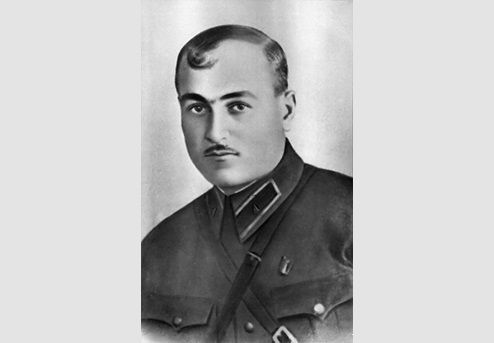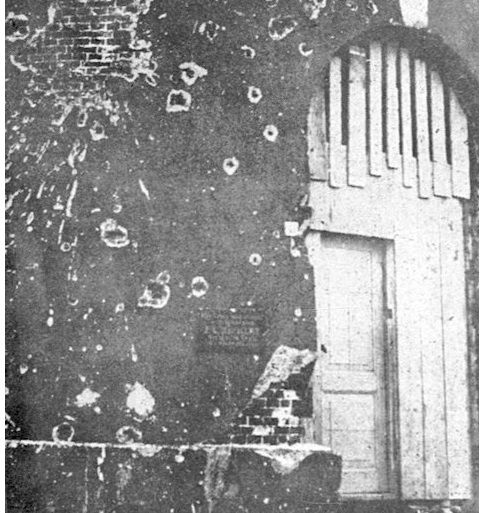The liberation of Texel is an extraordinary tale. You could say that on 17 June, when the last of the Georgian battalion leave, the war ended. But the liberation was not celebrated until 29 August. There are several sides to this violent and bloody story.
Many prisoners are taken during the advance of the German armies in Russia. They are placed in camps and live in appalling conditions. Not all of them are loyal followers of Stalin. Just like Hitler, he does not treat all of his subjects well. When the German army leaders decide that prisoners of war can be recruited for German service, many do.
Major Klaus Breitner decorates 1st lieutenant Basilius Indschia, dressed in traditional costume, in Zandvoort. Lieutenant Schalwa Loladze, leader of the Georgian uprising, stands on the right in the photo.
East battalions
During the war, 52 so-called East battalions are established. They are not sent to fight on the Eastern Front for fear they will immediately switch sides. The East battalions are sent to the Western Front, where they replace German soldiers who move to the Eastern Front, and man parts of the Atlantic Wall.
Georgian battalion
On 6 February 1945, a Georgian battalion replaces a Caucasian battalion of approximately 800 men on Texel. They had previously been stationed in Zandvoort. There is also a battalion of around 1,200 German military men on Texel. The Georgians hear via their contacts in the resistance, first in Zandvoort and later on Texel, how the war is actually developing for the Wehrmacht.
Fear of retaliations
There are two possible futures for them: be used to fight against the allied troops in the Eastern Netherlands and the fear of retaliations if they return to Russia after the war. The Georgians had, of course, committed treason. They served in enemy forces. From these prospects, the plan is developed to rise against the German troops on Texel, thus erasing this blemish.
Georgian Lieutenant Sjalwa Loladze, leader of the Georgian uprising.

Knives and daggers
On 5 April, the Georgian battalion commander, Sjalwa Loladze, receives orders from the Germans to get the troops ready to go to the front in the Eastern Netherlands. The Georgians decide to carry out their plan in the early morning of 6 April. The massacre begins at 1 am. They murder several hundred German soldiers at various places on the island with knives and daggers. This way they could carry out their plan quietly without alarming the Germans. But at some point, shots are fired and they do not succeed in killing all the Germans. At that moment, the rebels have control over two-thirds of the island. But the Germans begin a counteroffensive and call in the help of German units from Den Helder.
Bloody battle
The underground organisation on Texel also gets involved in the uprising. The Georgians call on the men of Texel to come and fight, but not a single one shows up. The Germans arrest 14 random Texel residents who they suspect of supporting the Georgians. The hostages are brought in a lorry to De Mok in the south. 4 men escape on the way and the others are executed on arrival. A bloody battle takes place during the coming days. Support troops arrive from Den Helder. Both the cannons there and those from the West-Battery on Vlieland are aimed at the island. Bit by bit, the Georgians are pushed back. Prisoners are executed immediately. The last rebel stronghold is at the Eierland lighthouse.

Arrival of the Canadians on Texel
On 20 May, the 1st Canadian army corps arrives on Texel. On 21 May, the Germans are brought to Den Helder. From here they leave to Wilhelmshaven. The island is left behind in shock. 117 Texelaars are dead. Around 600 Germans and probably 565 Georgians did not survive the battle. 467 of them are buried in the Hoge Berg.
The cemetery is named after the commander: Loladze. The first monument is erected on 15 June. It is desecrated by unknown vandals who do not agree with the homage shortly afterwards. On 17 June, the 236 surviving Georgian fighters leave Oudeschild on a boat to Wilhelmshaven.
Mixed emotions
The residents of the island have very mixed feelings. Opinions are divided on the island. Some see the rebels as heroes who dared to fight against the German occupiers, what the majority of the Dutch population did not dare to do. Others see them as traitors, assassins who first rose up against Stalin and then their German betters. Without the uprising, there would have been no deaths. The entire war was relatively calm, just like on the other islands. The Georgian uprising caused many deaths on all sides without any results.
Hero status
The results are horrible for everyone. But it must be told that the remaining Georgian battalion was the only East battalion to receive the status of heroes upon their return to the Soviet Union. All the other battalions disappear to punishment camps for a very long time.